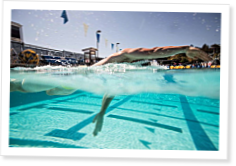
By mastering underwater swimming and breakouts after starts and turns, athletes can maintain speed off the wall and reduce race times.
In previous articles I’ve talked about basic elements of freestyle swimming: turns and starts. The element I intentionally left out was how to properly transition from a start or turn without deceleration upon surfacing. This article was written to help athletes of all levels improve race transitions.
Rules limit underwater travel in competitive swimming races to 15 m (or yards for American short-course pools) on any single length. The total distance traveled underwater can account for up to 30 percent of a long-course race distance and 60 percent of a short-course race. Mastering the hydrodynamics between the wall and the surface can pay huge dividends in both speed and efficiency, equating to faster times. Independent of stroke, the basic principles for getting from Point A (the wall) to Point B (the breakout) are the same whether coming off a turn or after the start or a race. These principles can be broken down into three steps:
1. Push-off and streamline—The push-off is covered in Torpedo School 2: Learn to Turn. I’ll focus on the specific points for an effective streamline in this article.
2. Underwater kick or underwater pull-out—Breaststroke races exclusively employ the underwater pull-out, which will be covered in a separate article on the breaststroke itself. The underwater kick for butterfly is the dolphin kick. For freestyle or backstroke, athletes have a choice to make. They may choose to use either the flutter or dolphin kick. I’ll go into the pros and cons of each, explain how to effectively employ the dolphin kick, and outline the optimal depth and distance to travel while underwater.
3. The breakout—The breakout is the transition point from underwater to surface swimming. I’ll discuss some key points to help create smooth transitions.
No comments:
Post a Comment